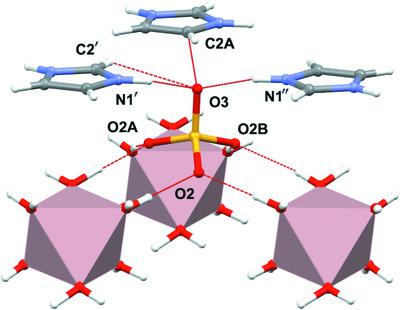当前位置:
X-MOL 学术
›
Acta Cryst. B
›
论文详情
Our official English website, www.x-mol.net, welcomes your
feedback! (Note: you will need to create a separate account there.)
Structure, ferroelasticity and Goldilocks zone phase transitions in C3H5N2Al(SO4)2·6H2O
Acta Crystallographica Section B ( IF 1.3 ) Pub Date : 2021-03-17 , DOI: 10.1107/s2052520621001256 Bartosz Zarychta , Zbigniew Czapla , Janusz Przesławski , Przemysław Szklarz
Acta Crystallographica Section B ( IF 1.3 ) Pub Date : 2021-03-17 , DOI: 10.1107/s2052520621001256 Bartosz Zarychta , Zbigniew Czapla , Janusz Przesławski , Przemysław Szklarz

|
The single crystal growth and sequence of reversible phase transition are described for C3H5N2Al(SO4)2·6H2O. Thermal and structural analyses combined with dielectric studies and optical observations revealed the structural phase transition at T1 = 339/340 K (I↔II) and T2 = 347/348 K (II↔III) on heating and cooling, respectively. Both phase transitions are of the first‐order type. The symmetry changes from monoclinic to trigonal phase. At 293 K, the large crystals are usually divided into numerous domains of the ferroelastic type that disappear above T1 on heating and reappear below T1 on cooling. The domain structure pattern is characteristic for the transition between trigonal and monoclinic phases. The changes of entropy and clear increase of permittivity at T1 provide evidence for the order–disorder character of this phase transition. The transition at T2 seems to be displacive.
中文翻译:

C3H5N2Al(SO4)2·6H2O的结构,铁弹性和Goldilocks区相变
描述了C 3 H 5 N 2 Al(SO 4)2 ·6H 2 O的单晶生长和可逆相变的顺序。热和结构分析与介电研究和光学观察相结合,揭示了T 1 =时的结构相变。加热和冷却时分别为339/340 K(I↔II)和T 2 = 347/348 K(II↔III)。两个相变均为一阶类型。对称性从单斜相变为三角相。在293 K时,大晶体通常被分为铁弹性类型的多个域,并在T 1以上消失加热时重新出现,并在冷却时重新出现在T 1以下。畴结构模式是三角相和单斜相之间过渡的特征。熵的变化和T 1处介电常数的明显增加为该相变的有序-无序特征提供了证据。T 2处的过渡似乎是可替代的。
更新日期:2021-04-12
中文翻译:

C3H5N2Al(SO4)2·6H2O的结构,铁弹性和Goldilocks区相变
描述了C 3 H 5 N 2 Al(SO 4)2 ·6H 2 O的单晶生长和可逆相变的顺序。热和结构分析与介电研究和光学观察相结合,揭示了T 1 =时的结构相变。加热和冷却时分别为339/340 K(I↔II)和T 2 = 347/348 K(II↔III)。两个相变均为一阶类型。对称性从单斜相变为三角相。在293 K时,大晶体通常被分为铁弹性类型的多个域,并在T 1以上消失加热时重新出现,并在冷却时重新出现在T 1以下。畴结构模式是三角相和单斜相之间过渡的特征。熵的变化和T 1处介电常数的明显增加为该相变的有序-无序特征提供了证据。T 2处的过渡似乎是可替代的。











































 京公网安备 11010802027423号
京公网安备 11010802027423号